 Local and visiting officers honor PFC Pitsor. Photo Courtesy of Al Gamboa
Local and visiting officers honor PFC Pitsor. Photo Courtesy of Al Gamboa
Photos, unless otherwise noted, and article by Mary Alice Murphy
Private First Class Richard Glenn "Dickie" Pitsor, born in 1923, entered the U.S. Army Air Forces from New Mexico and served in Company G of the 200th Coast Artillery Regiment in the Philippines during World War II.
The 200th Coast Artillery Regiment arrived in the Philippines in September 1941 and the soldiers were stationed at Fort Stotsenburg on Clark Air Base, Manila. After the Japanese invaded the Philippines, the regiment was sent to defend the Bataan Peninsula. According to records, the regiment did not receive adequate support in the way of arms, ammunition or food and medication.
The regiment surrendered to the Japanese and Pitsor became one of the American and Philippine soldiers who were forced on the Bataan Death March, so-named because of the many soldiers who died on the walk. Those who survived, including Pitsor, became prisoners of war at Cabanatuan Prison Camp. Pitsor died of dysentery at the camp on Aug. 28, 1942, and was buried in Common Grave 305, along with other deceased American soldiers.
According to https://dpaa-mil.sites.crmforce.mil/dpaaProfile?id=a0Jt0000000Llo2EAC , "Following the war, American Graves Registration Service (AGRS) personnel exhumed those buried at the Cabanatuan cemetery and relocated the remains to a temporary U.S. military mausoleum near Manila. In 1947, the AGRS examined the remains in an attempt to identify them. Those remains that could not be unidentified were buried at the Manila American Cemetery and Memorial as Unknowns. In January 2019, the Unknowns associated with Common Grave 305 were disinterred and sent to the DPAA (Defense POW/MIA Accounting Agency) laboratory for analysis. The laboratory analysis and the totality of the circumstantial evidence available established an association between one set of these unknown remains and PFC Pitsor." The DPAA announced the identification on March 20, 2023.
One record of the soldier identified two siblings, but did not give names.
Pitsor's remains flew into El Paso, on April 24, and were escorted to Baca's Funeral Chapel in Silver City by American Legion Silver City and Deming Riders.
They also led a procession from Baca's to Fort Bayard National Cemetery the morning of the reinterment, entering the cemetery under a flag at half-staff. Everyone stood at attention, with hand over heart, or saluting the truck that carried many American flags, as well as a U.S. Army flag that were then posted around the ceremony. Everyone continued to stand at attention as the hearse carrying the casket drove in.
At least 60-70 people attended the full military burial at Fort Bayard National Cemetery with a ceremony that featured a U.S. Army Honor Guard of six members from all over New Mexico, as well as from El Paso, Texas, according to an officer who said two of them had been under his command.
A bugler played Taps, followed by a rifle volley. Everyone stood as the honor guard pallbearers carried the casket, covered with an American flag, to its stand.
Two of the honor guard folded the flag, and their commander presented it to Leota Cole, who said Pitsor was her great-uncle.
Cole also received a gift from the Patriot Guard Riders and the Marine Corps League Detachment 1328 commandant.
And now PFC Pitsor has come home to Fort Bayard to be buried near where he lived. His father worked at the mines, and his mother, as a nurse at Fort Bayard Medical Center.
To pause the slide show, mouse over the image.